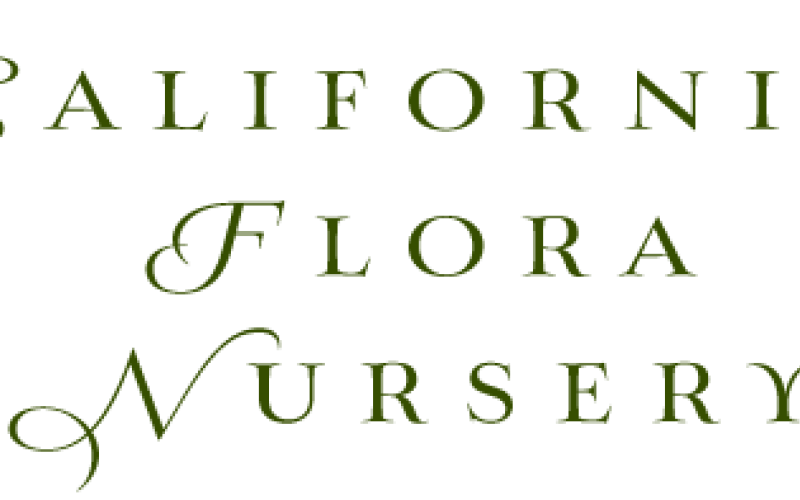Welcome to California Flora Nursery's very first eNewsletter
We are gearing up for spring and our greenhouses are full of seedlings, divisions and cuttings for the new season. As each week goes forward our availability will improve. We look forward to using this forum to alert you to new and interesting plants available for your gardens.
What makes Cal Flora Nursery distinctive is that we propagate and grow our own plants. Many nurseries buy in their plants from big wholesalers. Our offerings reflect our interests, explorations and our own gardens. We feel fortunate to have the talent of our staff contributing to our repertoire.

Liz Fial has worked at Cal Flora for 25 years. She heads up our late winter-early spring propagation. It's Liz who sees to the production of our many cultivars of California fuchsia and the beautiful monkey flower selections. Liz has a line of succulents which she grows for us, featuring Echeverias, Sempervivums, Sedums and Dudleyas. She is also our tech person and built our original website. In cooperation with Suzi Katz of Sequoia Web Design, we are able to bring you our new website and this eNewsletter.

Josh Williams is going on his forth year at Cal Flora and is becoming indispensable. He is skilled, knowledgeable and passionate about California native plants. Not only does he tend to the tasks of growing and caring for our crops, he has been contributing to our offerings from his home garden and adventures in the wild. Josh hikes regularly and collects seeds and cuttings wherever he goes. He has enhanced the richness and diversity of the plants available here at Cal Flora.

We are pleased Amber Huntington returns for another year. Amber works with Josh doing everything from potting to watering to sales. She is a Plant Biology major at Santa Rosa Junior College and is the Herbarium Curator at Pepperwood Preserve where she is researching masting patterns of Oregon Oak.

Phil Van Soelen and Sherrie Althouse have owned and operated California Flora Nursery for 30 years. Phil's garden in sunny Sebastopol features an extensive collection of manzanita. Sherrie gardens in different shades of shade beneath towering redwoods on the lower Russian River. We have been collecting and experimenting with a wide variety of plants that very often make their way into our nursery. Much of our spare time is spent hiking the wilds of Sonoma County, the San Francisco Bay Area and beyond. We are always on the lookout for interesting and useful plants to add to our offerings.
Grasses!
We have a good supply of native bunch grasses in four inch pots. Purple needlegrass, Idaho fescue, (a number of cultivars as well as a local seed strain), California fescue (several seed grown sources and the lovely selection 'Phil's Silver'), the adaptable deer grass, a fine selection of Pacific reed grass called 'The King', and California oatgrass. Also available are several cultivars of spreading red fescue and spreading sedges Carex pansa and Carex praegracillis. Also available is the sturdy Carex globosa and the beautiful blue-gray 'Elk Blue' Juncus patens.
On the non-native front we have some grasses offering colorful foliage. The beautiful Carex testacea with its fine textured orange blades, Uncinia with its rich mahogany tones and the chalky-blue 'Siskiyou Blue' fescue. In gallons we have the lovely, elegant, and adaptable Lindheimer's Muhly with its silver blades.

Right now we are offering Nassella pulchra in 4 inch pots for $2 each,
which is 50% off our retail price. Please remind us when paying.

Early Flowering Shrubs
One of the earliest blooming native shrubs are the manzanitas. Treasured for their dramatic form and structure, gorgeous red bark, and nodding bunches of white to pink urn-shaped flowers. Some manzanitas begin blooming in late autumn with varieties carrying us through March and April. They are an important early nectar source for hummingbirds, native and European bees. We have a nice variety of upright manzanitas in one gallons and some five gallons too. Manzanitas require a sunny position, good drainage, and are drought tolerant once established.
Currants and gooseberries offer a variety of early blooming choices and are unsurpassed for attracting hummingbirds. The spiny fuchsia-flowered gooseberry with its dangling crimson flowers are one of the first to bloom. Chaparral currant (Ribes malvaceum) blooms early too, often beginning in early November with its dangling racemes of pink flowers. Next come the pink flowering currants (Ribes sanguineum var. glutinosum) with varieties offering different shades of pink and even white pendulous flowers clusters.

Don't forget the Umbels!
Yampah, Lomatium, Angelica, and cow parsnip. What do these plants have in common? They are all members of the Apiacea family commonly known as the carrot or parsley family. Formerly called Umbelliferae, and named for the umbel or umbrella-shaped flower heads. The umbel is made up of many tiny flowers perfectly suited for ladybugs, parasitic wasps and predatory flies. Including members of this family in your garden provides habitat for the insects that will prey upon pests in your garden. The anise swallowtail butterfly uses members of the Apiacea as a larval food source for its caterpillars. Along with the habitat benefits, the architecture of these flowers are striking and bold and add great form to the garden. We have native umbels in stock now.

